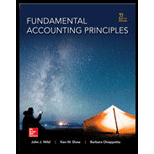
Introduction
Profit Margin Ratio: It is one of the profitability ratios calculated by dividing net income before tax by sales.
Investment (Assets) turnover ratio: This ratio is used to measure the operating performance. Normally this ratio is calculated by dividing net sales by assets. In this answer, we are considering average assets instead of fixed assets.
To Determine
- Return on Investment ratio
- Profit Margin ratio
- Investment turnover ratio
Answer to Problem 11E
Solution
- The return of Investment of beverage is 13.28% and cheese is 14.32%. Therefore, ROI of cheese is higher than that of beverage.
- The profit margin of beverage is 13.02% and cheese is 16.15%. Therefore, the profit margin of cheese is higher than beverage.
- The Divisional Investment assets turnover ratio of beverage is 1.02 and cheese is 0.08. Therefore, investment turnover ratio of beverage is more than that of cheese.
Explanation of Solution
Explanation
- To calculate Return on Investment, we need to calculate the Average of assets.
- Calculation of Profit Margin:
- Calculation of Investment (Assets) Turnover Ratio:
Therefore, Average assets on Investment in beverage Division are $2628 millions and in Cheese division, it is $4428 million.
Now, let us calculate the Return on Investment (ROI).
Hence, ROI of beverage is 13.28% and cheese is 14.32%. Therefore, ROI of cheese is higher than Beverage.
Hence, profit margin of beverage division is 13.02% and cheese division is 16.15%. The profit margin of cheese division is higher than beverage division.
Hence, Asset turnover ratio of beverage division is 1.02 and cheese division is 0.08. Therefore, Asset turnover ratio of beverage division is higher than cheese division.
Want to see more full solutions like this?
Chapter 24 Solutions
Fundamental Accounting Principles -Hardcover
- Dakota Manufacturing uses a standard cost system in which manufacturing overhead is applied to units of product on the basis of standard machine hours. During April, the company used a denominator activity of 40,000 machine hours in computing its predetermined overhead rate. However, 52,000 standard machine hours were allowed for the month's actual production. If the fixed manufacturing overhead volume variance for April was $9,000 unfavorable, then the total budgeted fixed manufacturing overhead cost for the month was $_. HELParrow_forwardCan you explain this general accounting question using accurate calculation methods?arrow_forward5 POINTarrow_forward
- Hello tutor please given General accounting question answer do fast and properly explain all answerarrow_forwardGabbana Manufacturing estimated that machine hours for the year would be 30,000 hours and overhead (all fixed) would be $150,000. Gabbana applies its overhead on the basis of machine hours. During the year, all overhead costs were exactly as planned ($150,000). There was $12,000 in over-applied overhead. How many machine-hours were worked during the period?arrow_forwardSub.General Accountarrow_forward
- Gabbana Manufacturing estimated that machine hours for the year would be 30,000 hours and overhead (all fixed) would be $150,000. Gabbana applies its overhead on the basis of machine hours. During the year, all overhead costs were exactly as planned ($150,000). There was $12,000 in over-applied overhead. How many machine-hours were worked during the period? Need helparrow_forwardTropical Furnishings, Inc. had net cash from operating activities of $178,000. It paid $140,000 to buy new manufacturing equipment by signing a $110,000 note and paying the balance. Net cash from (or used for) investing activities for the period was _.arrow_forwardHi expert please given correct answer with accounting questionarrow_forward

 AccountingAccountingISBN:9781337272094Author:WARREN, Carl S., Reeve, James M., Duchac, Jonathan E.Publisher:Cengage Learning,
AccountingAccountingISBN:9781337272094Author:WARREN, Carl S., Reeve, James M., Duchac, Jonathan E.Publisher:Cengage Learning, Accounting Information SystemsAccountingISBN:9781337619202Author:Hall, James A.Publisher:Cengage Learning,
Accounting Information SystemsAccountingISBN:9781337619202Author:Hall, James A.Publisher:Cengage Learning, Horngren's Cost Accounting: A Managerial Emphasis...AccountingISBN:9780134475585Author:Srikant M. Datar, Madhav V. RajanPublisher:PEARSON
Horngren's Cost Accounting: A Managerial Emphasis...AccountingISBN:9780134475585Author:Srikant M. Datar, Madhav V. RajanPublisher:PEARSON Intermediate AccountingAccountingISBN:9781259722660Author:J. David Spiceland, Mark W. Nelson, Wayne M ThomasPublisher:McGraw-Hill Education
Intermediate AccountingAccountingISBN:9781259722660Author:J. David Spiceland, Mark W. Nelson, Wayne M ThomasPublisher:McGraw-Hill Education Financial and Managerial AccountingAccountingISBN:9781259726705Author:John J Wild, Ken W. Shaw, Barbara Chiappetta Fundamental Accounting PrinciplesPublisher:McGraw-Hill Education
Financial and Managerial AccountingAccountingISBN:9781259726705Author:John J Wild, Ken W. Shaw, Barbara Chiappetta Fundamental Accounting PrinciplesPublisher:McGraw-Hill Education





